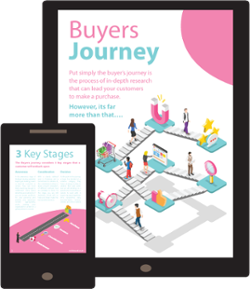Many marketing professionals are looking for ways to better understand and serve their customers. If you are involved in marketing in any way, Marcus Sheridan's book 'They ask, you answer is a highly recommended read. As the founder of the US inbound marketing agency Impact, Marcus has led the charge in creating content that is tailored to the needs of buyers. The book provides a framework for creating content that is customer-centric and focused on answering customer questions. It also includes tips and tricks for creating and distributing this content effectively.
For those unfamiliar with the inbound methodology, it posits that 'active buyers' are more valuable and likely to convert than 'passive buyers'. How does one define an active buyer? An active prospect looks for solutions to problems or opportunities actively
The benefits of inbound marketing methodology are numerous. Inbound marketing revolves around creating valuable content and experiences that attract customers and leads instead of interrupting them with advertisements.
Nowadays, customers are more likely to do their research and make purchasing decisions, so this approach is more effective and efficient. As customers become more sophisticated and resistant to traditional advertising techniques, inbound marketing has become increasingly effective. Inbound marketing also allows businesses to track and measure results more effectively, so they can adjust their strategies as needed to continue achieving their desired results.
At Real Inbound, we specialise in helping businesses across a wide range of industries to grow and succeed using the inbound methodology. We focus on attracting active buyers, which means that we can scale our marketing efforts more effectively and get repeatable results. This also makes it easier for the sales team to close deals, and it enhances the likelihood that each prospect will become a customer. It's a win-win for everyone involved!
However, how does this relate to "They ask, you answer"?
Answering questions that prospects have about your products, service, and industry is key to creating marketing plans and content that will grow sales. Prospects are not experts in your field, but they still need to educate themselves on the range of options available to them so their decision, when made, is informed and correct for their unique needs. By taking a question-led approach, you can help them do just that."
The process for acquiring leads online is always evolving, but there are a few key steps that remain the same. Start by doing your research online and identify the most common questions related to your product or service. Then, structure your responses in a way that is helpful and informative, and finally, implement a 'They ask, you answer' approach. By following these steps, you'll be able to more effectively engage with potential customers and convert them into leads.
The ‘They ask, you answer’ Questions
There are a lot of different ways that you can find out what questions people are asking. You can use sites like Answer the Public or Google Trends to get an idea, but there might be an even more valuable source. Read on to find out which questions your prospects are asking and what you can do to inspire them.
But once you’ve found the questions, how do you know which to answer and how to address them effectively?
Answering ‘They ask, you answer’ Questions
A good way to focus your content strategy is by finding out which questions are most popular among your target audience. Google Trends is a great resource for this. Not only will you be able to see which questions are being asked most frequently, but you can also get an idea of which questions have the biggest business impact. For example, if you manufacture pre-built kit homes and a common question your sales team wastes time answering is "do you build on-site," writing a blog post about that topic could dramatically increase your sales. When you respond to questions that demonstrate the client isn't a good fit, you enable them to move forward and find another option.
After you have a list of potential questions, it can be helpful to prioritise by frequency. It may be worthwhile to address a question that gets asked a lot sooner rather than later, to assist those who come up against the same problem repeatedly. Even though many people focus on blogs to answer customer questions, your website is just as useful for answering questions. The use of a blog can sometimes negatively affect your search engine ranking (more on that below).
To help you better understand what your customers want and ultimately find what they’re looking for, you should consider asking them to fill out a questionnaire. Customers tend to be candid in answering questions, and this can help you understand what’s important to them. You can use the answers to improve your product or service so that they will continue to do business with you. Apart from customer surveys, you can give your visitors the option to remain anonymous when submitting a question or comment. This will help you avoid the frustration of being constantly asked the same question.
How to respond to the question. Now to the second part of the question. In some cases, it may not be obvious what the answer to a core question is. For example, if a core question is being asked constantly, then perhaps you have failed to explain what you do, and don’t do, as well as you could. Are those details there, but can't be found? Is there a simpler way to explain it? Do you make it difficult for researchers to find the answer themselves because you make the question so difficult? Is your appearance deceiving? Having explained that an adjustment to the website won't stop users from asking the question, let's examine another option.
But before you dedicate all your time to pumping out blog content, remember that Google may penalise web pages that have less than 300 words. This means that posting a quick news update or blog article could hurt your website's search engine optimisation. To avoid this, make sure that the blog posts you do write are high quality and offer value to your readers.
If you're feeling stuck trying to come up with a blog that's a full 1,000 words, consider other possibilities. Your FAQ page is a great resource for sharing simple answers, and Google will still pick it up when indexing pages and displaying them in search results. When it comes to more complicated topics that require a multi-faceted approach or explanation in sections, however, a blog is an excellent option.
The ‘They ask you answer’ Blog Article
The "They ask you answer" approach to content can be very effective, and for many people, blogging is the best way to go about it. Blogs are easy to find through search engines, and they allow you to address an issue in greater detail. That said, there are a few drawbacks to using blogs for this purpose.
Google and other search engines generally don't rank short content as well as longer content. They do so because they want to provide users with the most relevant search results. Pages with fewer than 300 words can be flagged as problematic by Google. As a result, optimising for search engines is difficult. To rank well for questions typed into Google, you have to create great responses that add value to the user.
To help, you can take some structural steps.
- Title your post with a question
- Use the question feature as the page's H1 (heading 1)
- A minimum of 1,000 words is required
- Summarise key points with lists and bullet points
- Make sure the image alt text includes the question
- The meta description of your blog should include the question
- To answer the question further, offer complimentary resources
There is no one-size-fits-all answer to the question of how to structure a blog post for success, but following the rough guide above definitely helps. Keep in mind that writing a blog is no guarantee of success, but it's still worth doing since it's better than leaving the question unanswered or giving your competitors space to jump in and win the top spot-on Google.
The first step is to understand the user's needs before trying to answer their question. By taking the time to assess what they are trying to achieve, you can provide them with a better response. For example, if they are trying to compare two possible solutions, you can give them a side-by-side comparison. If they have a problem that needs fixing, you can provide them with a step-by-step solution. By taking the time to understand the context of their question, you can give them a more tailored answer.
Answering the Question
There are a few key things to remember when you sit down to write a blog post if you want it to be successful. First, you need to make sure that your argument is clear and concise. Second, you need to back up your argument with concrete evidence and examples. And third, you need to make sure your post is well-written and free of any grammar or spelling errors. following these tips will help you write a persuasive blog post that is worth your time and effort.
1 - Plan Your Journey
Beginning your article with a clear and concise introduction is vital to keeping your reader's attention focused throughout. Just as any good journey should have a beginning, middle, and end, so too should your article. The introduction should introduce the challenge at hand, the solutions you will consider, and the purpose of the article. An article's middle section should lay the foundation of knowledge, while its end section should provide concrete results that the reader can use. Keep your promises in check throughout, and make sure to deliver on them by the end!
2 - The Conversation
Your writing style is like a conversation. You wouldn't jump between talking to different people in the middle of a sentence, would you? The same goes for your copy. Use words like ‘you’ and ‘your’ when you want to address the reader directly. For referencing other parties, use ‘they’ or ‘them.’ Just be sure to indicate who is speaking. ‘I’ represents the writer speaking directly. ‘We’ could be a group (like a company) speaking personably
3 - Complete the SEO Checklist
You want your article to have a good ranking on Google, so be sure to include the question in the title and main header. You can also use keywords in the alternate text for images, and hyperlink to related information that might be useful to readers.
4 Increase Reach by Maximising Resources
"If you're hoping that just putting your blog articles out there will be enough to bring in a flood of organic traffic, think again. 'Build it and they will come only works in the movies. You can't just expect people to find your new blog post. You need to actively send visitors to it through social media posts, emailing, and by making it easily accessible on your website. An initial influx of traffic to a page helps Google determine that it's a high-quality piece of content, which means it would be beneficial to others. Follow the 'They ask, you answer' philosophy if you don't use email marketing and social media regularly.
5 - Continue Building Upon Previous Posts
Consistency is key when it comes to writing a blog. You need to make sure that you are writing regularly, and this can be a challenge for some businesses. Being excited about an inbound-focused content marketing strategy might mean that a lot of articles are created at first, but you don’t want the momentum to die down. Make sure you have a “bank” of 2-3 articles that you can use to keep emails and social posts constantly pushing new content.
Blogging has always been a powerful tool for SEO, but it's also great for attracting new customers and re-engaging with old ones. If you're looking to get started with blogging or to take your current efforts to the next level, make sure you set some realistic goals, research your audience's needs, and commit to producing inbound-focused blog content regularly.
If you want to try inbound marketing but are worried about not having the tech skills or time to write monthly blog posts, we can help. We're experts at writing SEO-friendly blog posts and promoting them through email and social media to reach new and current customers.




